

Jerónimos Monastery

Jerónimos Monastery
The Hieronymites Monastery (Mosteiro dos Jerónimos,) is located in the Belém district of Lisbon, Portugal. This magnificent monastery can be considered one of the most prominent monuments in Lisbon and is certainly one of the most successful achievements of the Manueline style. In 1983 it was classified by the UNESCO, with nearby Torre de Belém, as a World Heritage Site.
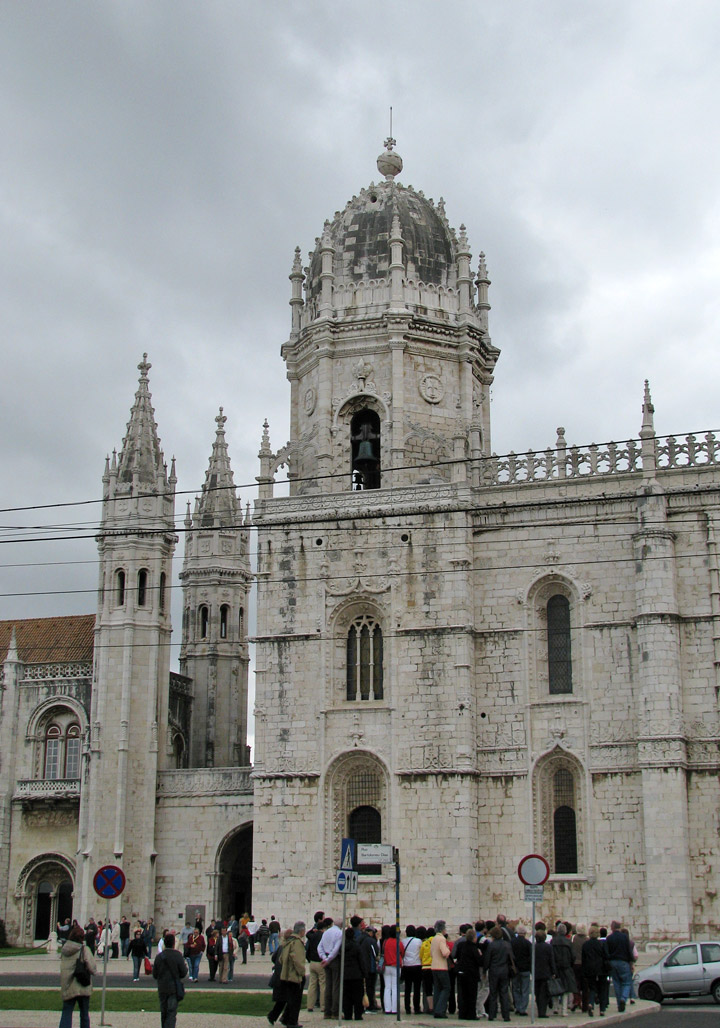
church on the right, monastery on the left
The house for the Hieronymite monks was built on the same site of the Ermida do Restelo, a hermitage that was founded by Henry the Navigator at about 1450. It was at this hermitage, that was already in disrepair, that Vasco da Gama and his men spent the night in prayer before departing for India in 1497.
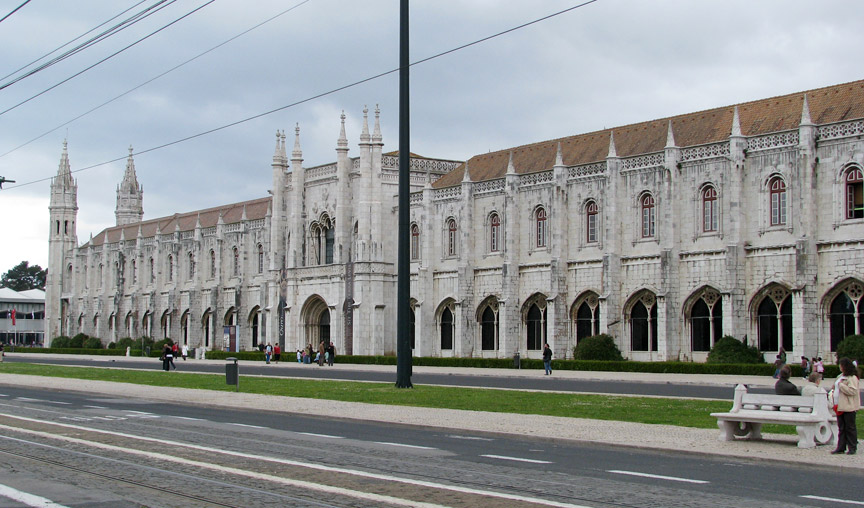
monastery wing
Kneeling statue of King Manuel I - main sponsor of the Monastery - on the Western portal. The figure behind the king is St Jerome.

The existing structure was started on the orders of Manuel I (1515-1520) to
commemorate Vasco da Gama's successful return from India. It was originally
meant as a church for the burial of the House of Aviz, but it also became a
house of prayer for seamen leaving or entering port.
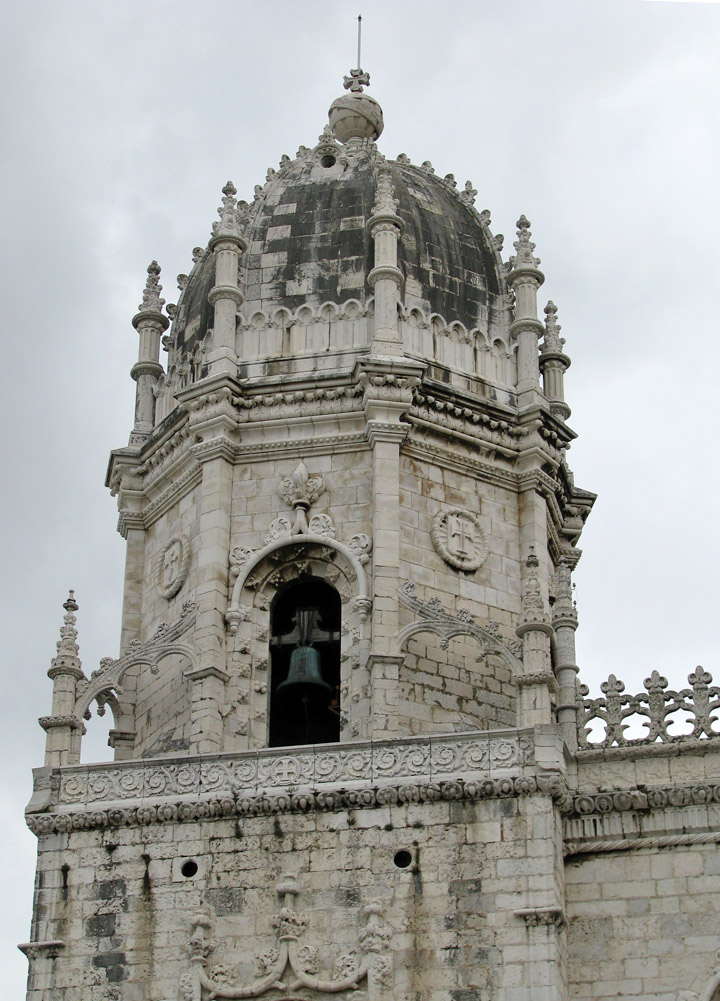
church spire
Construction of the monastery began in 1502 and took 50 years to complete. He used pedra lioz, a local gold-coloured limestone, for its construction. The building of the monastery was funded by a 5% tax on eastern spices, with the exceptions of pepper, cinnamon and cloves, revenue from which went straight to the Crown. By this influx of riches, the architects had enough financial margin to think big. The enormous amount of funds needed for this monastery, meant abandoning the construction of the Aviz pantheon in the Monastery of Batalha.

The monastery was designed in the Manueline style by Diogo de Boitaca (who was
probably one of the originators of this style with the Igreja de Jesus in
Setúbal). He built the church, the monastery, the sacristy and the refectory. He
was succeeded by the Spaniard João de Castilho, who took charge of construction
in around 1517. João de Castilho gradually moved from the Manueline style to the
Plateresco style, a style with lavish decorations that remind of silver ware (plata
= silver). There were several sculptors who made their mark on this building.
Nicolau Chanterene added depth with his Renaissance themes. The construction
came to a halt when the king Manuel I died in 1520.
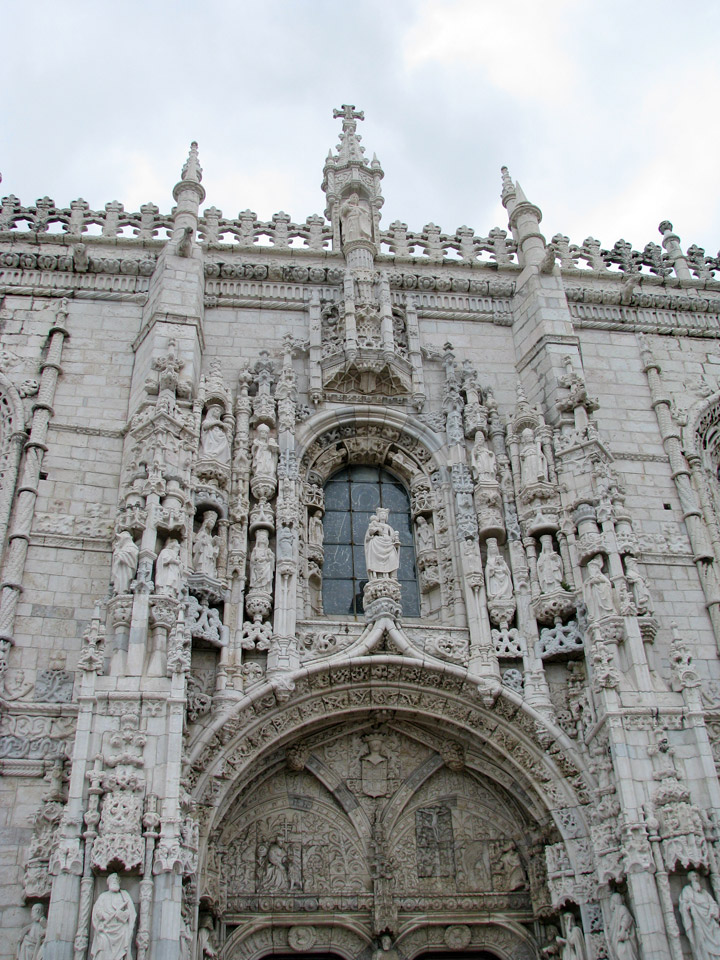
The architect Diogo de Torralva resumed the construction of the monastery in
1550, adding the main chapel, the choir and completing the two storeys of the
monastery, using only Renaissance motifs. His work was continued in 1571 by
Jérôme de Rouen (also called Jerónimo de Ruão) who added some Classical
elements. The construction stopped in 1580 with the union of Spain and Portugal,
because the building of the Escorial in Spain was now draining away all the
funds.s.

The monastery withstood the Great Earthquake of 1755 without too much damage.
But when the building became vacant in 1833 by the abolition of the religious
orders in Portugal, it began to deteriorate to the point of almost collapsing. A
cupola was later added to the southwestern tower.
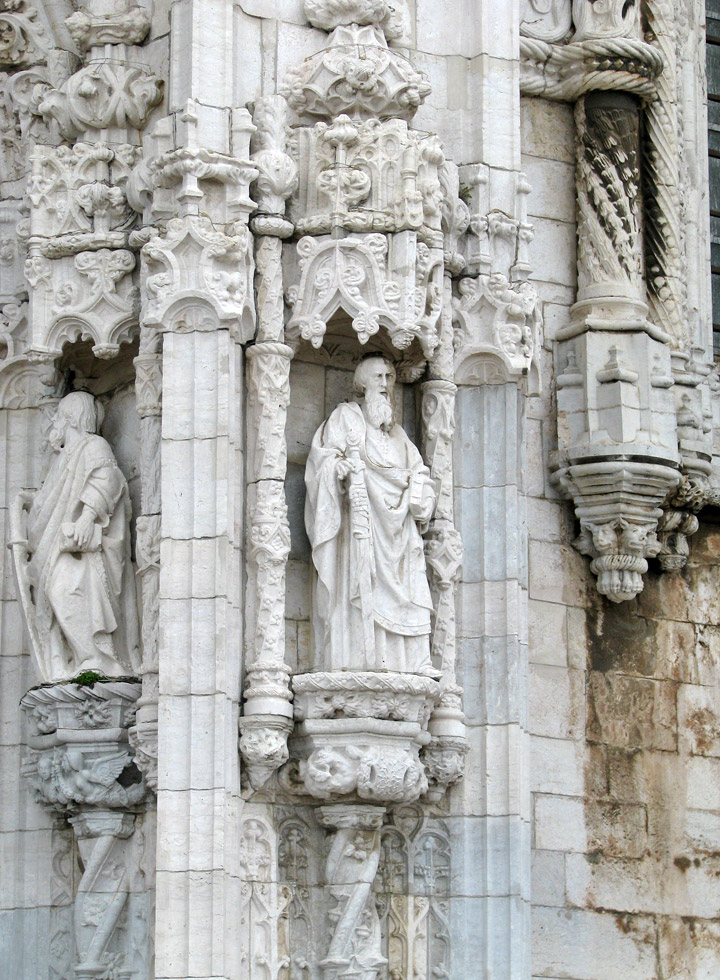
On December 13, 2007 the Treaty of Lisbon has been signed at the monastery,
laying down the basis for the reform of the European Union.

The ornate main entrance to the monastery was designed by João de Castilho and
is considered as one of the most magnificent of his time. This shrine-like
portal is large, 32 m high and 12 m wide, extending up for two stories. It
features, surrounded by an abundance of gables, pinnacles, many carved figures
standing under a baldachin in exquisitely carved niches, around a statue of
Henry the Navigator, standing on a pedestal between the two doors.
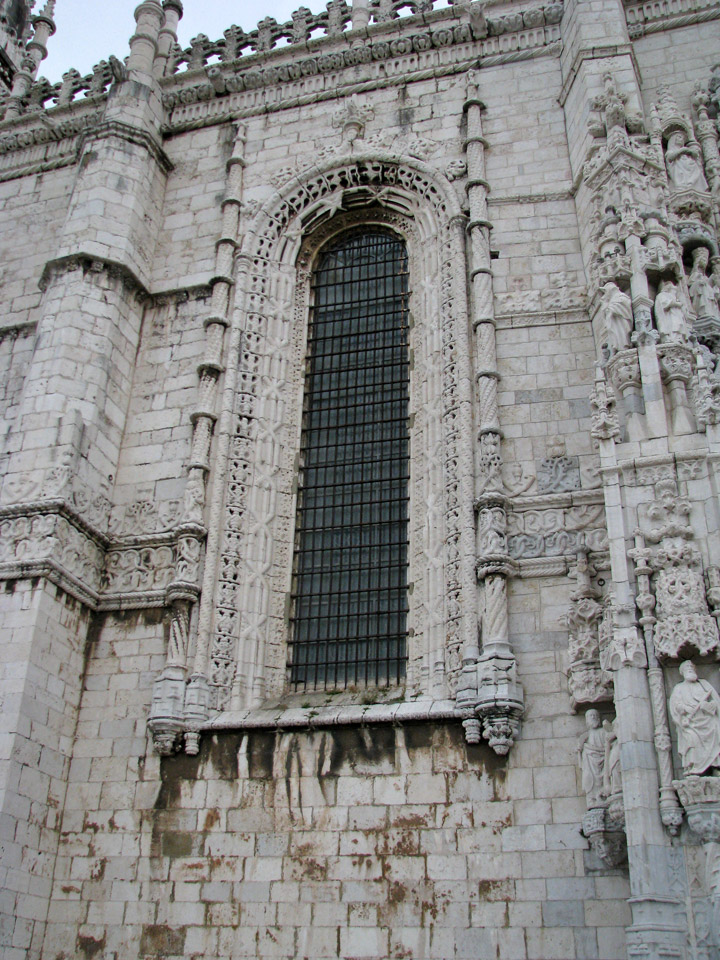
The tympanum, above the double door, displays in half-relief two scenes from the
life of St. Jerome. On the left, the removal of a thorn by St. Jerome from a
lion's paw, after which the lion became his best friend. The right scene depicts
the saint in the desert. The spandrel between these scenes shows the
coat-of-arms of king Manuel I. The statue with the sword in the niche of the
pier probably represents Henry the Navigator Wherever one looks in the archivolt
and tympanum, one sees all the elements of the Manueline style.
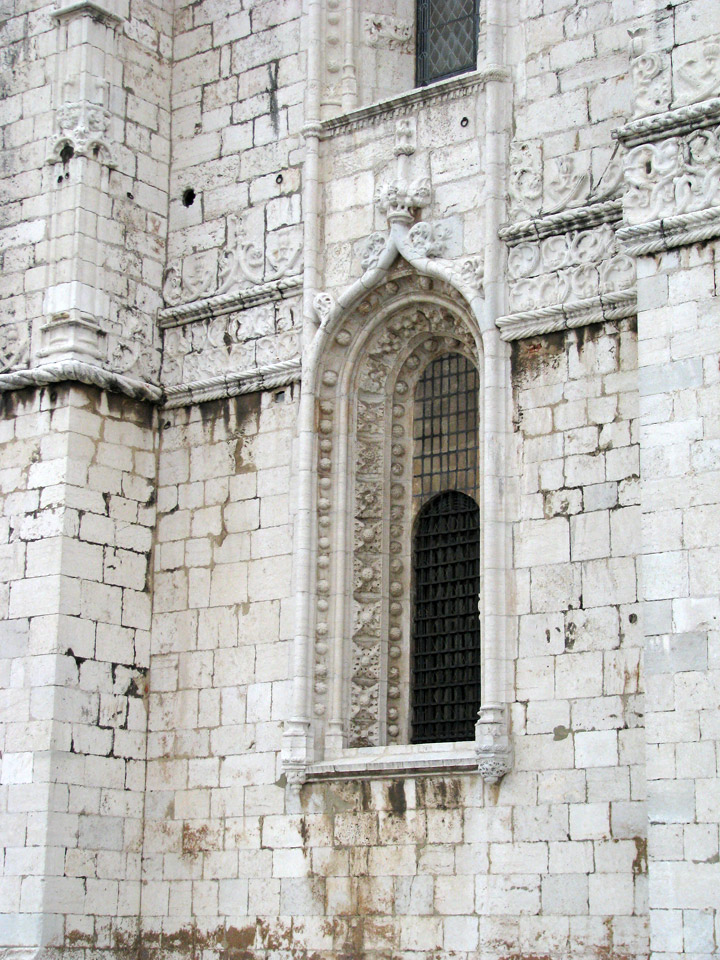
The Madonna of Belém stands on a pedestal on top of the archivolt, above it
stands a statue of the Archangel Michael and on top of the portal stands the
cross of the Order of Christ. The portal is harmoniously flanked on each side by
a large window with richly decorated moldings.

This western portal is a good example of the transition from the Gothic style to
Renaissance. It was built by Nicolau Chanterene in 1517. This was probably his
first commission in Portugal. It is now spanned by a vestibule, added in the
19th century, that forms a transition between the church and the ambulatory.

The tympanum depicts the Annunciation, the Nativity, and the Epiphany. Two
angels, holdings the arms of Portugal, close the archivolt. The splays on each
side of the portal are filled with statues, among them king Manuel I and his
second wife Maria of Aragón, kneeling in a niche under a lavishly decorated
baldachin. They are flanked by their patron saints St. Jeronimos and John the
Baptist.
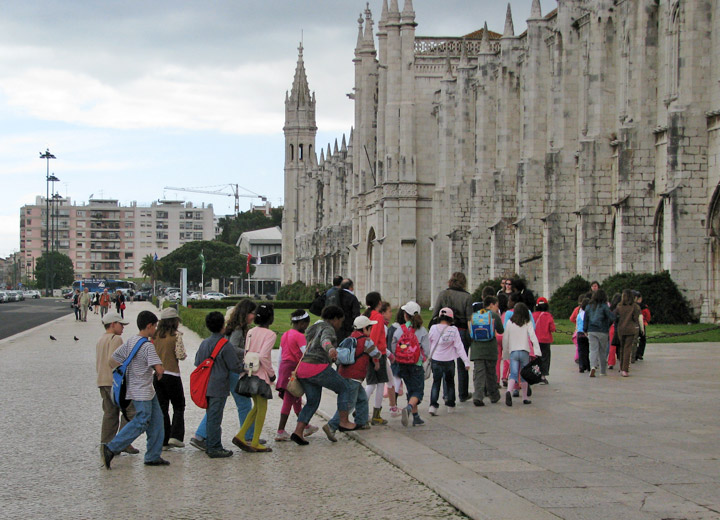
required visit for school children
The supporting corbels are decorated with little angels holding the coat-of-arms and, at the side of the king, an armillary sphere and, at the side of the queen, three blooming twigs.

Neomanueline tomb of navigator Vasco da Gama.
More Photos of Vasco da Gama tomb
Diogo Boitac laid the foundations for this three-aisled church with five bays under a single vault, a clearly marked but only slightly projecting transept and a raised choir. The aisles and the nave are of about equal height in the manner of a hall church. Boitac built the walls of the church as far as the cornices and then started with the construction of the adjoining monastery.
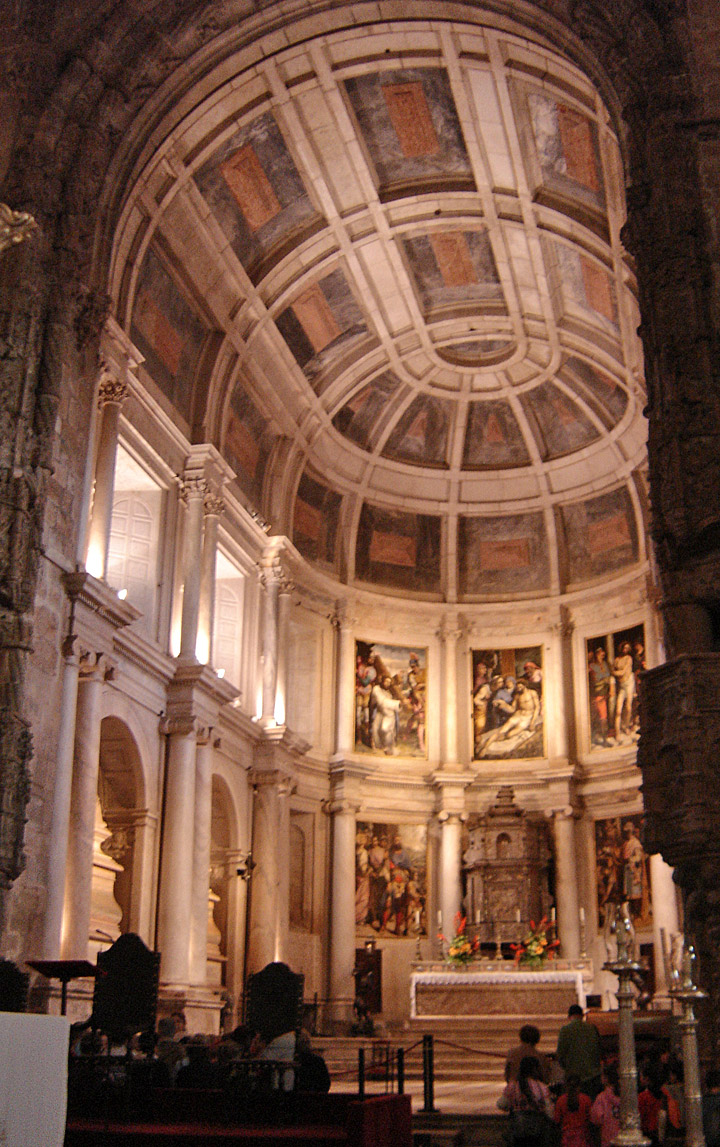
church altar
João de Castilho, a Spanish architect and sculptor, continued the construction in 1517. He completed the retaining walls and the unique single-span ribbed vault, a combination of stellar vaulting and tracery vaults spanning the 19 m-wide church. Each set of ribs in the vaulting is secured by bosses. The bold design (1522) of the transversal vault of the transept lacks any piers or columns, while Boitac had originally planned three bays in the transept. The unsupported vault of the transept gives the viewer the impression as if it floats in the air.
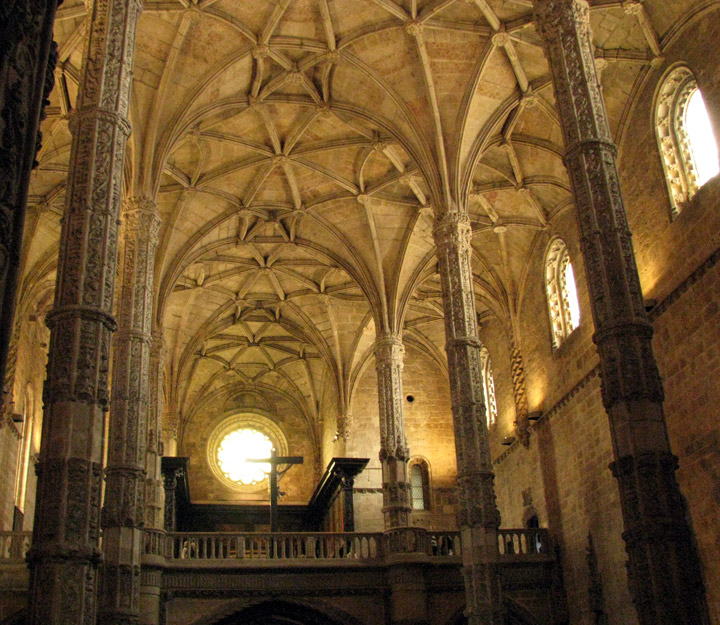
interior vaulting
Royal tombs in the main chapel. Each sarcophag is held by two elephants.

He also ornamented the six 25m-high, slender, articulated, octagonal columns
with refined grotesque or floral motives announcing the Renaissance style. The
northern column closest to the transept shows a medallion that probably is a
portrait of Boitac or João de Castilho.
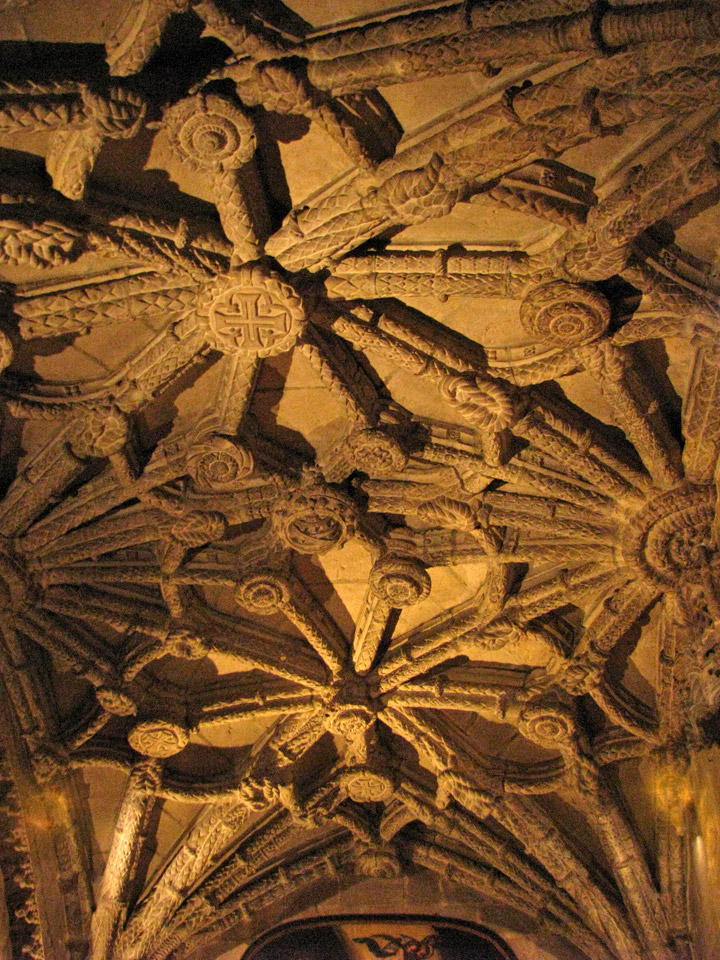
The end result of the construction of this Late Gothic hall church is
aesthetically and architecturally a masterwork. It augments the spatial effect
of this vast building.
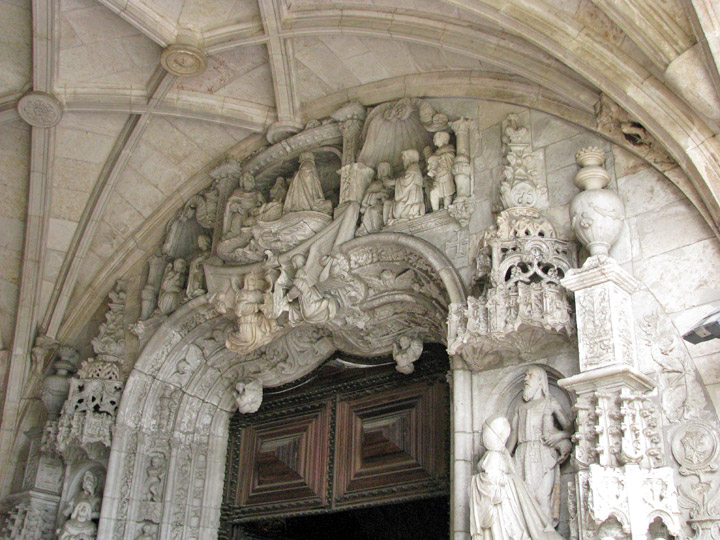
At the end of the side aisles and on both sides of the choir stand Manueline
altars dating from the 16th and the 17th centuries. They are decorated with
carved work in golden and green colours. One of them has a statue of St. Jerome
in multi-coloured enamelled terracotta.

This chancel was ordered by Queen Catarina of Spain as the final resting place
for the royal family. It is the work of Jerónimo de Ruão (Jean de Rouen) in
Classical style. The royal tombs rest on marble elephants and are set between
Ionic pillars, topped by Corinthian pillars. The tombs on the left side of the
choir belong to king Manuel I and his wife Maria of Aragon, while the tombs on
the right side belong to King João III and his wife D. Catarina of Spain.
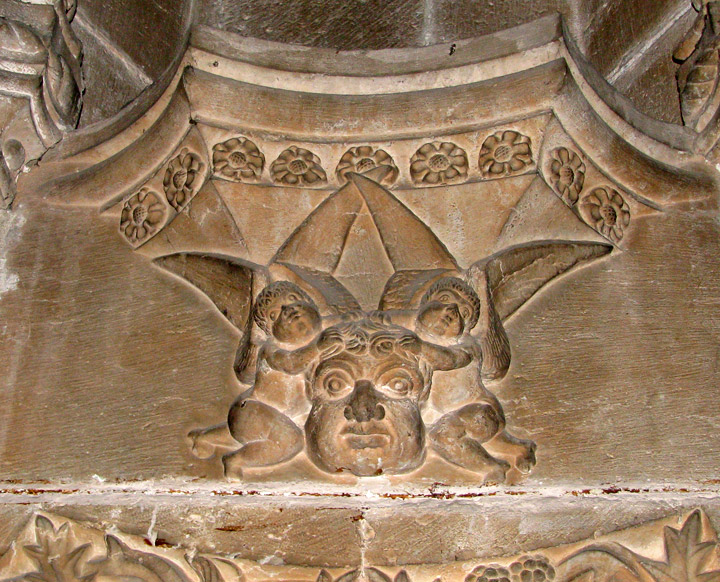
Within the church, close to the western portal, are the stone tombs of Vasco da
Gama (1468-1523), and of the great poet and recorder of the discoveries, Luís de
Camões (1527-1570). Both tombs were sculpted by the nineteenth century sculptor
Costa Mota in a harmonious neo-Manueline style. The mortal remains of both were
transferred to these tombs in 1880.
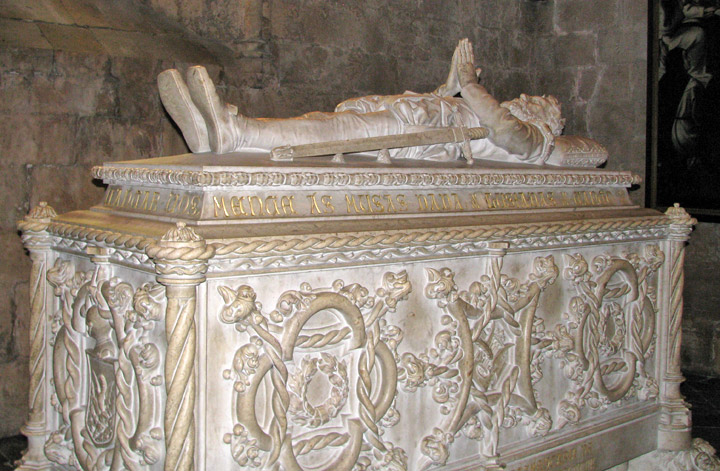
tomb of Luís de Camões (1527-1570).

Work on the vast square cloister (55 x 55 m) of the monastery was begun by
Boitac. He built the groin vaults with wide arches and windows with tracery
resting on delicate mullions. João de Castilho finished the construction by
giving the lower storey a classical overlay and building a more recessed upper
storey. The construction of such a two-storey cloister was a novelty at the
time. Castilho changed the original round columns of Boitac into rectangular
ones. He put Plateresque-style ornaments on it.
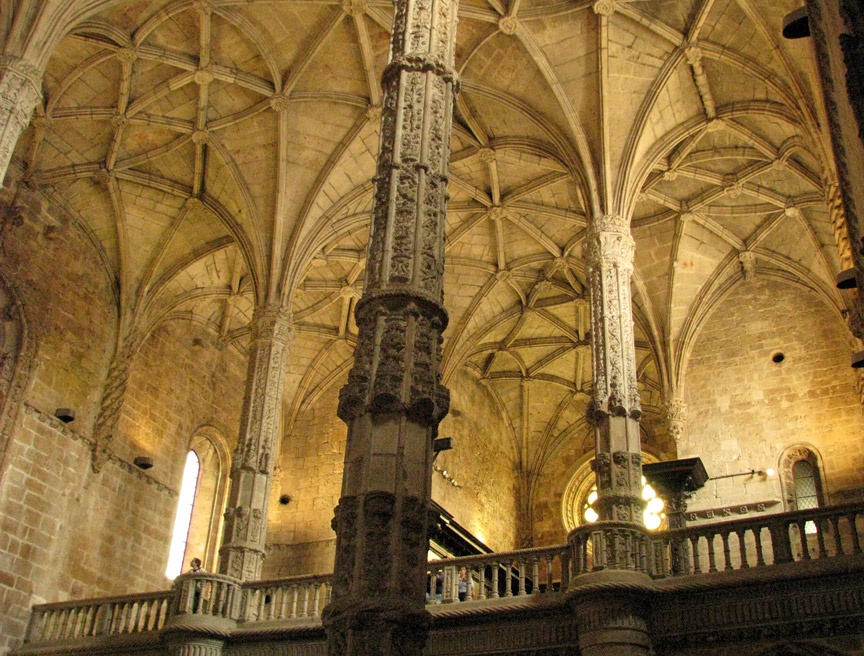
Neomanueline column
Each wing consists of six bays with tracery vaults. The four inner bays rest on massive buttresses, forming broad arcades. The corner bays are linked by a diagonal arched construction and show the richly decorated corner pillars.

The inside walls of the cloister have a wealth of Manueline motives with
nautical ornaments, and European, Moorish ans eastern elements. The decorations
on the outer walls of the inner courtyard were made in Plateresco style by
Castilho. This ornamentation on the walls and the traceried arches of the
arcades give the construction a filigree aspect.
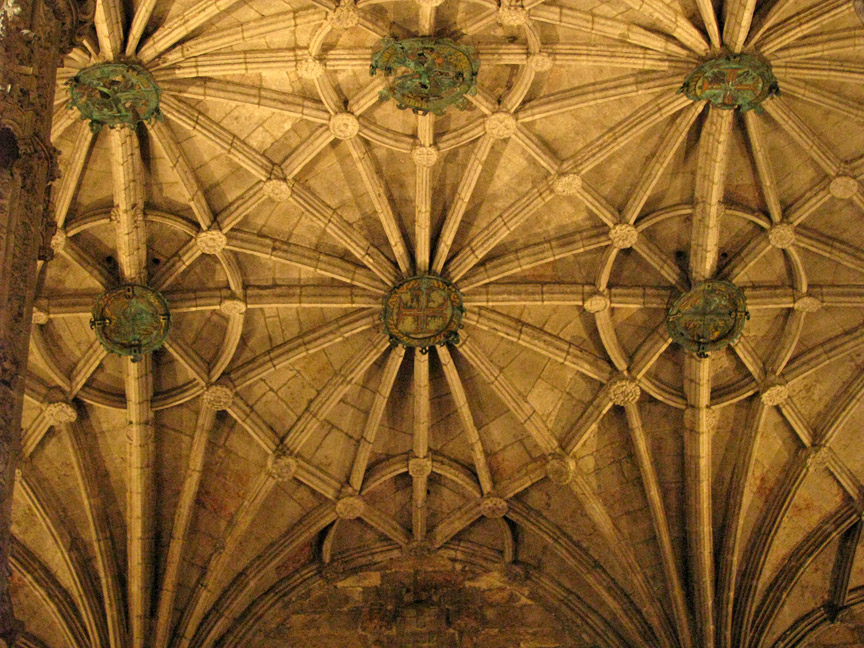
The round arches and the horizontal structure are clearly in line with the
Renaissance style, while at the same time there is also a relationship with
Spanish architecture.
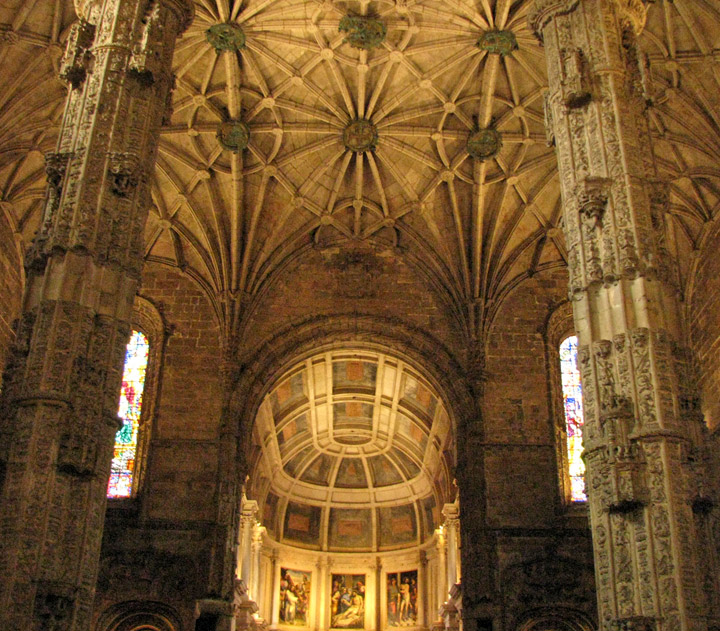
One of the arcades contains the sober tomb of the poet Fernando Pessoa. There
are several tombs in the chapter house : poet and playwright Almeida Garrett
(1799-1854), writer-historian Alexandre Herculano (1810-1877), president Teófilo
Braga (1843-1924) and president Óscar Carmona (1869-1951). The refectory across
the chapter house has several azulejos tiles from the 17th century.
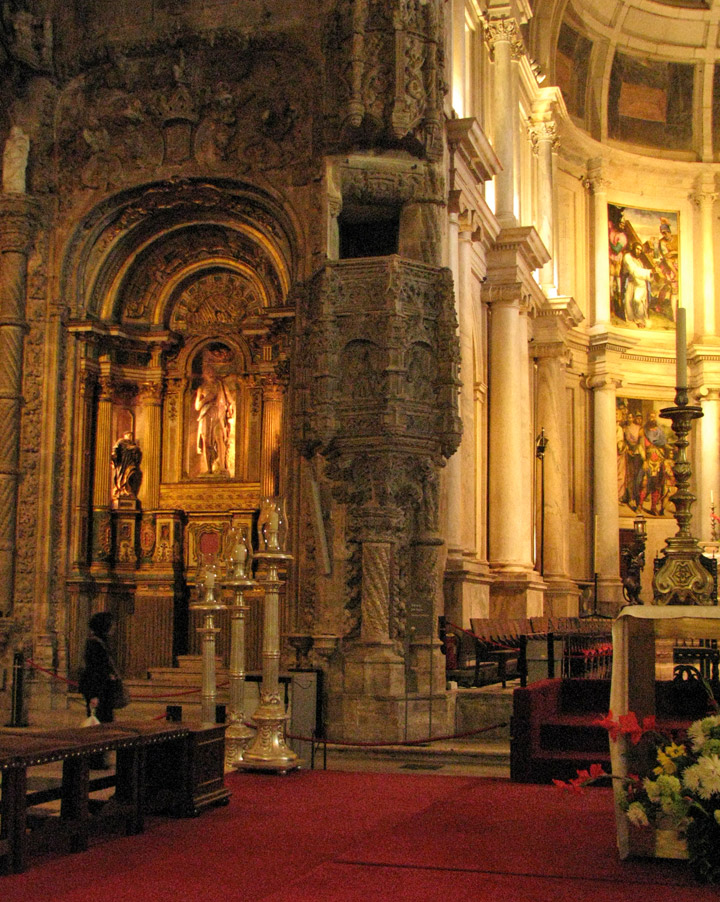
The cloister had a religious function as well as a representative function by
its decorative ornamentation and the dynastic symbolic motives, such as the
armillarium, coat-of-arms, and the cross from the Order of Christ, showing the
growing world power of Portugal.
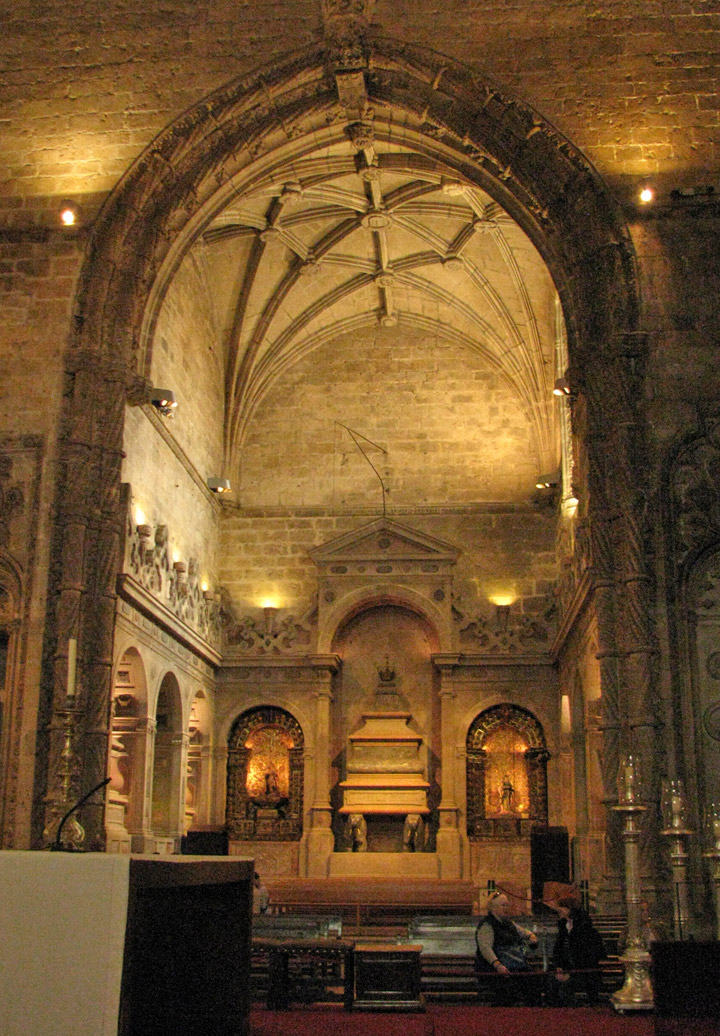
In an extension, added to the monastery during the restoration 1850, is located
the Museu Nacional de Arqueologia (National Archaeological Museum). The Museu da
Marinha (Maritime Museum) is located in the west wing.
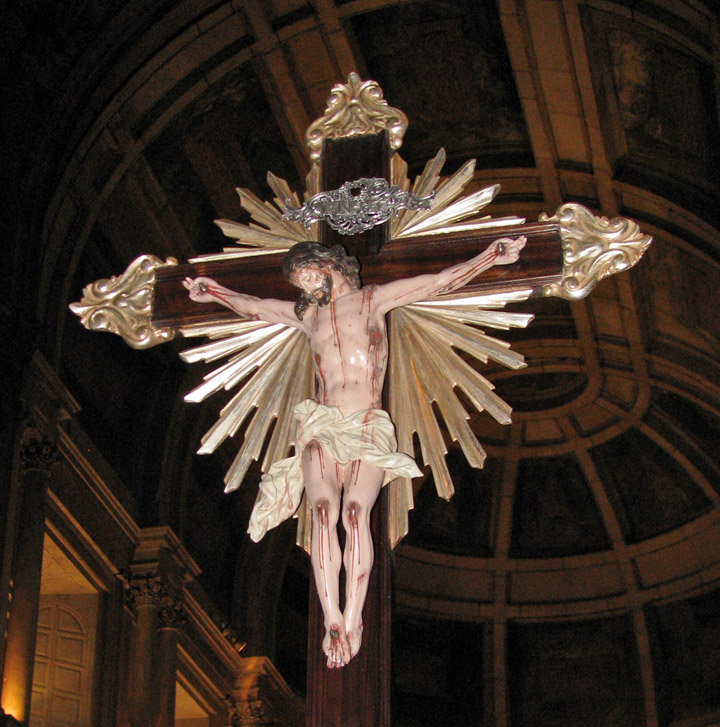
The church and the monastery, like the nearby Torre de Belém and Padrão dos
Descobrimentos, symbolises the Portuguese Age of Discovery and is among the main
tourist attractions of Lisbon.
Text from Wikipedia